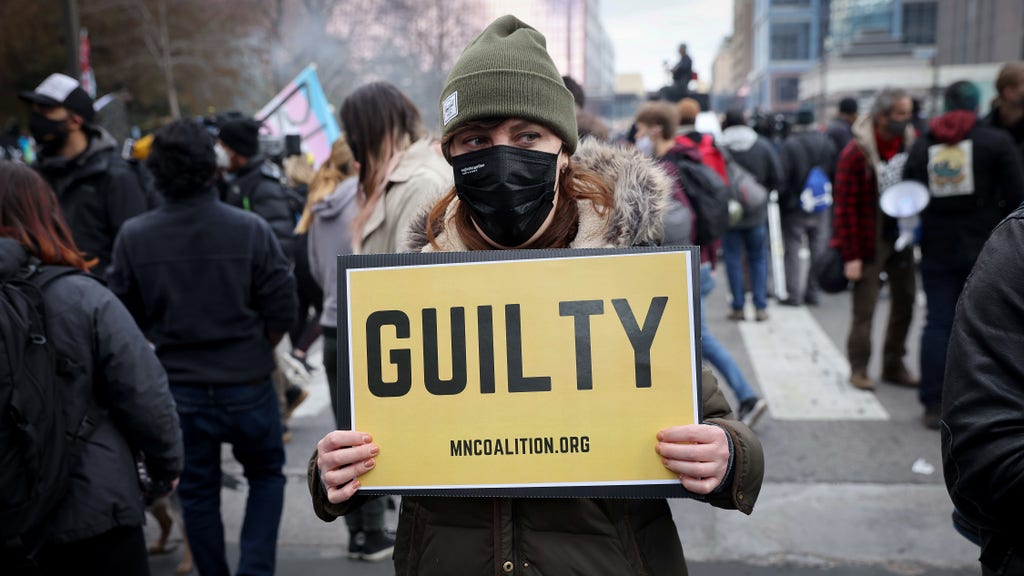“Justice for George” is the message on the banner unveiled by civil rights activists Jennifer O’Brien and Holly Robins, amid a crowd at the intersection of Chicago Street and 38th Street in Minneapolis. It’s a manual, sewing job, which they took with them to various demonstrations awaiting verdict against former police officer Derek Chauvin.
Now they are carrying the message in triumph.
– He is very emotional. This is a big step for Minneapolis, Minnesota and the United States, says Jennifer O’Brien.
Gbenga Olubomo, who recently moved to Minneapolis from New York, is one of many who would like to take a photo with knitting.
– I am happy today. It finally turned out to be true, he says.
Eleven months ago This place in southern Minneapolis was marked by despair and despair. Police enter the Cup Foods store turned into an attack.
For 9 minutes and 29 seconds, police officer Derek Chauvin kept his knee pressed against African American George Floyd’s neck – even though the man on the street complained about his inability to breathe and shouted helplessly at his mother, despite angry listeners who Urge the police to do so. The process is suspended, and despite the fact that Floyd finally lacked a pulse.
The jury at Hennepin County Courthouse found guilty of what classifies as second degree murder, third degree murder and second degree murder. Three crimes in Sweden can be compared to seriously causing the death or perhaps murder of another person.
Many say that Their eyes filled with tears when they received the message.
– I was with my daughter and my grandson. I wanted to share this historic moment with them. We all cried. And that means a lot, not just for black citizens but for many minorities, says Pamela Wems.

Pamela Wiss remembers the protests in the 1960s.
Photo: Karen Erickson
You have reached the memorial site to participate in the community as Minneapolis history writes. It is accompanied by several hundreds of Minneapolis residents chanting slogans and chanting or placing flowers at the spot on the street where George Floyd took his last breath.
It’s important for me to be involved when I wrote Minnesota History. this is my home. I am a black woman with a black man, and I have black brothers and I may have a black son. It is important for me to represent them in a way that can lead to change, says Bernice, who does not want to give her last name.
Near a statue With a fist clenched into the metal, a brass band plays, and some visitors make spontaneous dance moves. A woman spreading incense with the scent of rosemary. Set offers free vegetable soup from a large pot.

A brass team walked to the intersection of Chicago Street and 38th Street.
Photo: Karen Erickson
Joy and comfort are evident. But it is mixed with sadness and contemplation.
Philip Crawford lived all his life – 62 years – near Chicago Street. He finds it difficult to express the meaning of judgment with Chauvin.
– I think of my ancestors. I’m thinking of Rodney King. I think of all the blacks who were killed and all the times we said “now someone will be held accountable.” Usually it never happens. But that has happened now, he says.
I’m not saying we can breathe, but maybe we can take a breath.
Notes by Philip Crawford The past eleven months have been revolutionary for the people of Minnesota and the twin cities of St. Paul and Minneapolis.
As for whites, Minneapolis was good to live in. But not for minorities. We had a movement in the 1960s when we walked in and got some change. Now he says we see young people from different ethnic backgrounds see injustice and collaborate together.
In the middle of the trial against Derek Chauvin, the city was shaken by new tragedy, when Don Wright was killed by a bullet in a traffic control post in the suburb of Brooklyn Center. The last week of George Floyd’s death trial was marked by new demonstrations and demonstrations.
In the final days leading up to the jury letter, the atmosphere in Minneapolis was tense, with a major security raid and several roadblocks, roads and roadblocks in the city. Innocence could have led to widespread riots.
Churches in Minneapolis He had representatives in the neighborhood surrounding the monument site every day during the trial.
I feel overjoyed that what I regard as Adalah won and I feel great for the city. Innocence meant a lot of pain. Now there is a chance for us to heal, Reverend Stephanie Laudec says.

Pastors Bonnie Wilcox and Stephanie Lodtk arrived at the memorial site in the afternoon. Churches had representatives on site every day during the trial.
Photo: Karen Erickson
Next to her, a middle-aged white man and a black young man raise their fists in the air. They are father and son Scott and Silas Anderson. They are overwhelmed.
– Last summer, I felt divided. Now I feel like we’re coming together, Silas Anderson says.
Scott’s father notes that Minneapolis was a very distinguishable city:
I hope it will change now and that we understand the dialogue and understand each other better.
Read more:

“Falls down a lot. Internet fanatic. Proud analyst. Creator. Wannabe music lover. Introvert. Tv aficionado.”




More Stories
Meteorologist on Storm Boris: ‘We expect more flooding’
More than 100 Republicans rule: Trump is unfit | World
Ignore the warning – over 100 people died